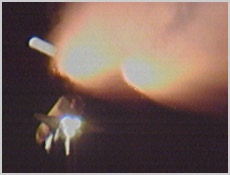This picture was taken on February 16, 2001, by the crew of the ISS. The crew took the picture of the underside of the shuttle as the shuttle pulled away from the ISS. The picture was taken with a digital camera.
Click on image for full size
Courtesy of NASA
Coming Home from the ISS
News story originally written on February 21, 2001
After several missed landing opportunities due to weather, the Atlantis shuttle landed at Edwards Air Force Base on February 20, 2001, at 2:33 p.m. CST. This STS-98 mission
carried 5 astronauts and the Destiny laboratory to the International Space Station (ISS). The crew of Atlantis helped the ISS crew to connect the Destiny laboratory to the ISS. Destiny was sucessfully installed on February 11, 2001.
Another shuttle will visit the space station in early March - the Discovery shuttle as part of STS-102. The Discovery shuttle will bring the 2nd crew for the ISS. These team members are Yury Usachev, James Voss and Susan Helms. The Discovery shuttle will then give the 1st ISS crew a ride home! The 1st crew of the ISS, Yuri P. Gidzenko, Sergei K. Krikalev and William M. Shepherd, have been aboard the station since November 2, 2000. I'm sure by early March, they will be anxious to come home to Earth where they can grab a hot shower and a pizza whenever they want!
Discovery will also carry the Leonardo Multipurpose Logistics Module to the ISS. This Italian-built module will act as a moving van for laboratory materials that will be put into the newly delivered Destiny laboratory.
You might also be interested in:

The Shuttle Atlantis had a perfect launch on February 7, 2001. It lifted off just after 6 p.m. EST, carrying 5 astronauts and the Destiny laboratory to the International Space Station (ISS). The astronauts
...more
It was another exciting and frustrating year for the space science program. It seemed that every step forward led to one backwards. Either way, NASA led the way to a great century of discovery. Unfortunately,
...more
The Space Shuttle Discovery lifted off from Kennedy Space Center at 2:19 p.m. EST, October 29th. The sky was clear and the weather was great as Discovery took 8 1/2 minutes to reach orbit for the Unitied
...more
A moon was discovered orbiting the asteroid, Eugenia. This is only the second time in history that a satellite has been seen circling an asteroid. A special mirror allowed scientists to find the moon
...more
Will Russia ever put the service module for the International Space Station in space? NASA officials are demanding an answer from the Russian government. The necessary service module is currently waiting
...more
During a period of about two days in early May, 1998, the ACE spacecraft was immersed in plasma associated with a coronal mass ejection (CME). The SWICS instrument on ACE, which determines unambiguously
...more
J.S. Maini of the Canadian Forest Service has referred to forests as the "heart and lungs of the world." Forests reduce soil erosion, maintain water quality, contribute to atmospheric humidity and cloud
...more















